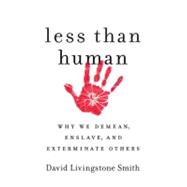
| Acknowledgments | p. vii |
| Preface: Creatures of a Kind Somewhat Inferior | p. 1 |
| Less Than Human | p. 11 |
| Steps Toward a Theory of Dehumanization | p. 26 |
| Caliban's Children | p. 72 |
| The Rhetoric of Enmity | p. 103 |
| Learning From Genocide | p. 132 |
| Race | p. 163 |
| The Cruel Animal | p. 202 |
| Ambivalence and Transgression | p. 224 |
| Questions for a Theory of Dehumanization | p. 263 |
| Psychological Essentialism | p. 275 |
| Paul Roscoe's Theory of Dehumanization in War | p. 277 |
| Notes | p. 281 |
| Index | p. 317 |
| Table of Contents provided by Ingram. All Rights Reserved. |
The New copy of this book will include any supplemental materials advertised. Please check the title of the book to determine if it should include any access cards, study guides, lab manuals, CDs, etc.
The Used, Rental and eBook copies of this book are not guaranteed to include any supplemental materials. Typically, only the book itself is included. This is true even if the title states it includes any access cards, study guides, lab manuals, CDs, etc.